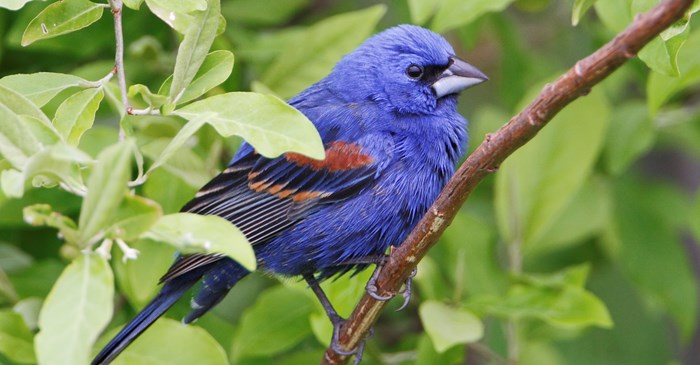If you’re one of the lucky ones, your feeders have been discovered by the Blue Grosbeak. In late summer and fall, Blue Grosbeaks will join up with the flock to feast on grains as they prepare to migrate to Mexico and Central America. But these handsome birds may also discover the bird feeder banquet in your backyard, especially if you live in an area with plenty of shrubs.
When you see the males in full light, they’re very striking: deep blue plumage, and distinctive from other blue birds with their rust brown bars on their black wings. In indirect light, they may appear black or sparrow-brown. (Females, on the other hand, sport no trace of blue, but are rust brown and tawny.) And, being part of the grosbeak and bunting family, their silver beaks are stout and conical, ideally suited for cracking seeds.
In the summer, the Blue Grosbeak can be found across the southern half of the U.S., with their territory slowly inching farther north. When it comes to finding their summer breeding grounds, they’re not ones to flock in suburban areas. They prefer wild fields and shrubby areas. Through the summer, Blue Grosbeak is often seen hopping on the ground, searching for grasshoppers, beetles and other insects among the low-foliage. To find them out in their habitat, take time to learn their warbling song, because oftentimes, this is a bird that’s easier to find if you can hear them first.
As they make the autumn trek to Central America, the eastern birds take a different journey than their out-west counterparts. Birds that summer out west make the trip across land, but the eastern birds fly across the Gulf of Mexico. That’s an amazing feat to contemplate, considering the adult Blue Grosbeak weighs in at all of 1 ounce, about what a slice of bread weighs.
The Blue Grosbeak can be drawn into seed-filled feeders in shrubby yards. Lyric Supreme Mix has the variety of high-quality seed, like black oil sunflower seed, white proso millet, cracked corn and canary seed, to help them fuel up for the long journey.
